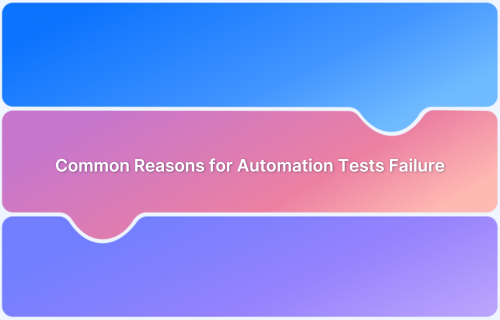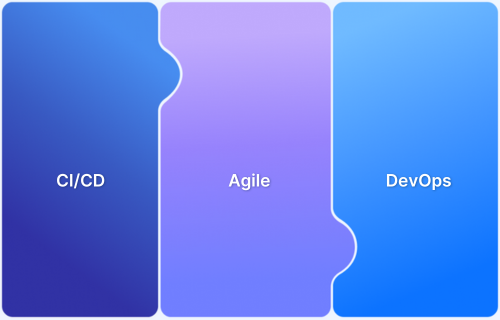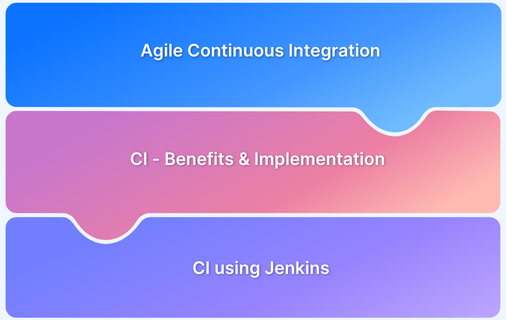Continuous Integration is a software integration practice that involves regularly integrating code changes to a shared code repository. This practice helps automate code integration and testing in software development, facilitating better code quality and smooth collaboration.
Optimizing your test cases for continuous integration is essential to make the most of it. It helps identify issues earlier, minimize build times, prevent roadblocks, and facilitate faster feedback, eventually enhancing the quality of your software.
This article discusses the strategies to optimize test cases for continuous integration in detail.
What is Continuous Integration (CI)?
Continuous Integration refers to a software integration practice that involves regular integration of code changes to a shared code repository.
Generally, integration occurs several times a day. This practice prioritizes committing small code changes frequently rather than infrequent big changes. Every commit triggers a build, which involves running a number of tests that identify if already existing features have been broken by new changes.
How to optimize tests for Continuous Integration (CI)?
For optimizing your test cases for continuous integration, automate your tests and leverage parallel execution for faster runs. Try to create smaller tests, minimize redundancy in tests and maintain a stable test environment etc. for streamlining continuous integration.
Here are the main strategies you can follow to optimize test cases for CI and maintain a fast and efficient development pipeline:
Strategies to Optimize Test Cases for Continuous Integration:
- Utilize Automation Testing
- Leverage Parallel Testing
- Test Environment Management
- Adapt to Shift-left testing
- Restructure the Test Setup
- Focus on Wait Times
- Test Isolation
- Monitor Test performance
- Create Smaller Tests
- Caching Mechanisms
- Utilize Automation Testing
In a non-CI environment, test suites are normally initiated by human intervention. Modify these scripts so as to include them in the CI pipeline. This means setting them up to run automatically whenever a change occurs to the code repository.
Automate the tests that find problems which are usually difficult to fix. By identifying the problems sooner, the team will have more time to fix it. Such tests are very valuable but usually take some time to execute. Thus, automating them would also save the time it would take to initiate them manually.
Try Automation Testing for Free
- Leverage Parallel Testing
Parallel testing enables the running of multiple tests simultaneously on multiple devices and browsers. This is one of the most effective ways to speed up tests and create an effective CI pipeline.
Let’s imagine that a vital test suite contains four hundred and sixty-eight test cases. This would take several hours to run in a linear fashion. However, if it is broken down into a dozen different suites that can run in parallel, the time taken is much lower. The tests can also be run more frequently, which results in a more thorough verification of code quality.
When a test suite takes too much time to execute, try breaking it down so that it can be run in parallel.
Optimizing tests for a CI pipeline is bound to significantly improve the testing process. However, remember that this requires the use of the right tools. Automated testing, in general, requires a robust test automation framework like Selenium that is, ideally, connected to a vast range of real browsers and devices.
This is where BrowserStack comes in. By providing a cloud Selenium grid of 2000+ real browsers and devices, it offers testers the opportunity to run tests as and when necessary with incurring the cost and effort of an in-house lab. BrowserStack also offers integrations with a vast number of CI/CD tools, thus making it the perfect platform to help optimize tests for Continuous Integration.
- Manage Test Environment
Maintain a stable and consistent test environment for effective test execution. Ensure your test environment replicates the production setup with proper data, configurations, and dependencies. You can also automate your environment setup and teardown in order to maintain consistency and save time.
- Adapt to Shift-left Testing
Follow shift-left testing, i.e include testing activities earlier in the development lifecycle. When codes are tested as they are written, errors can detected and fixed much sooner, thereby saving the time and cost of resolving the issue at a stage when the codes are much complex. Leverage unit tests, API tests etc; earlier on in the development process to identify and resolve issues early and improve efficiency of the CI pipeline.
- Restructure the test setup
Tests begin with a setup phase, and then perform the steps for verification. When testing a music streaming app, the test should check if the app is saving a song to the user’s library after it has been clicked on to play. To do this, the test has to be set up with the song first.
This setup phase can be restructured for better alignment with a CI-focused work ethic. For example, let’s say a team is running a suite of UI-driven tests that are time-consuming and lead to false failures because of timing and slight UI changes.
If the test setup is restructured to be performed via API commands and the verification is done through the UI, it will have the same functional coverage but will be executed significantly faster. False failures due to UI changes will also be reduced notably.
- Focus on wait times
Imagine the scenario: a test keeps failing because back-end elements did not respond in time. That, or a resource (possibly some external dependency) is still loading. Therefore, a sleep statement was put in as a temporary fix or workaround.
This works for a while, but if these statements are left in, they will cause unnecessary delays. Try replacing them with wait statements that complete when a predetermined event occurs, instead of ending after a fixed period of time.
- Test Isolation
With test isolation, each test can be executed independently without depending on shared states, external date or the results of other tests. This reduces the risk of flakiness and lets you debug easily since failures can be traced back to specific code modifications. Use mock data, clear dependencies, and reset the test environment before every run to isolate tests properly.
- Monitor Test Performance
Make it a point to track your test suite to detect slow or flaky tests that might affect the CI pipeline. You can integrate your CI pipeline with tools like BrowserStack to track pass/fail rates of tests, identify flaky tests, and visualize them through reports. Optimize inefficient tests and remove test redundancy and flakiness to facilitate an efficient pipeline.
- Create smaller tests
Smaller test suites run faster. Reorganize all necessary tests into smaller suites. This is especially necessary for tests that approve the code for further testing. In other words, if these tests are not positive, then the code should not be tested further.
A good way to design these tests is: perform the most important function first. For example, if a writing app is being tested, then the first test should be automating the following functions:
– Open the app, add text, save, close app, reopen, and check that the right text has been saved.
If any of these functions fail, then there is a fundamental flaw that needs to be solved first.
- Caching Mechanisms
By reusing dependencies or data that was generated previously, caching mechanisms reduce redundant operation and accelerates test execution. Caching dependencies reduce resource consumption and shorten build times during CI runs.
Benefits of Optimizing Tests for CI
Here are the main benefits of optimizing your test cases for continuous integration (CI):
- Faster Feedback: Helps detect issues faster and lets developers address them immediately.
- Improved Efficiency: Shortens the execution time, facilitating frequent builds and quicker development lifecycle.
- Higher Code Quality: Optimizing test cases for CI helps in early error detection, ensuring error-free and efficient codes in production.
- Resource Optimization: By removing redundant and unwanted tests, system resource consumption can be reduced.
- Cost-efficiency: With reduced testing time and minimized production defects, you save time and money in the long run.
- Better Reliability: With the lesser occurrence of flaky tests and consistent results, you enhance the reliability and stability of the CI pipeline.
Conclusion
Optimizing tests for a CI pipeline is bound to significantly improve the testing process. However, remember that this requires the use of the right tools. Automated testing, in general, requires a robust test automation framework like Selenium that is, ideally, connected to a vast range of real browsers and devices.
This is where BrowserStack comes in. By providing a cloud Selenium grid of 3500+ real browsers and devices, it offers testers the opportunity to run tests as and when necessary with incurring the cost and effort of an in-house lab. BrowserStack also offers integrations with a vast number of CI/CD tools, thus making it the perfect platform to help optimize tests for Continuous Integration.







